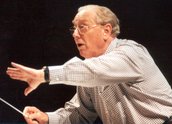
Sydney Opera House Opening Concert (1973)
Synopsis
The ABC concert-telecast broadcast of the official opening concert at the Sydney Opera House Concert Hall on 29 September 1973. Performed by the Sydney Symphony Orchestra, it was conducted by expatriate Australian conductor Charles Mackerras and featured Swedish soprano Birgit Nilsson.
Curator’s notes
The first official public concert in the Concert Hall at the Sydney Opera House on 29 September 1973 featured the Swedish soprano Birgit Nilsson. She was accompanied by the 110-member Sydney Symphony Orchestra conducted by Charles Mackerras, then 48, yet to be knighted (1979) and a former oboist with the orchestra during the fabled ‘Goossens decade’ (1946-56).
Nilsson sang the celebrated aria ‘Dich, teure Halle’ from act two of Wagner’s opera Tannhauser. Nilsson, 55 at the time, was at the height of her powers and it was a superb performance (clip one).
In fact, the entire program was devoted to the music of Richard Wagner (1813–83). Some saw this as deflecting from Australia’s history and identity, as well as delivering a backhander to its composers. Some members of the RSL were also unimpressed: what, they wondered, were we doing celebrating the opening of Sydney’s Opera House with the music of Hitler’s favourite composer?
The month leading up to the concert was an historic time for Sydney. In the middle of a transport strike, a petrol strike, a mail strike, a series of rolling power strikes and a garbage collection strike came the opening events of the Sydney Opera House.
Seventeen years earlier, in 1956, the NSW State Government announced an international competition to design a building to house opera, music, theatre, ballet and the performing arts. The Danish architect Jørn Utzon created sketches that were both revolutionary and breathtaking. Disputes between the architect and NSW government bureaucrats caused Utzon to leave Australia in February 1966; his interior designs were altered, the functions of both major halls were reversed and the opening date was pushed back time after time. The delays and shifting dates made it impossible to secure planned appearances by Dame Joan Sutherland (1926–2010) or Leonard Bernstein and the New York Philharmonic Orchestra.
Finally, on 17 December 1972, all seemed to be in readiness. Sir Bernard Heinze conducted a ‘test concert’ for the site workers (and music critics) and plans for the official opening proceeded full steam ahead. In early October 1973, the Cleveland Orchestra led by Lorin Maazel played four concerts over a week. One of their soloists was the Swedish diva, Birgit Nilsson, who was to feature in the opening concert a few weeks later.
Barely a month after the concert, on 20 October, the Sydney Opera House was formally opened by Queen Elizabeth II, a moment in history that was threatened by more strikes, visits by Imelda Marcos and a bevy of heads-of-state and Hollywood types, even the prospect of a terrorist attack by the PLO. The Queen attended performances of Beethoven’s Ninth Symphony in the Concert Hall and Mozart’s opera The Magic Flute, also conducted by Mackerras. The first official operatic performance in the Opera Theatre was Prokofiev’s War and Peace on 28 September.
In the intervening years, the reservations about the appropriateness of opening with the music of Wagner disappeared and Sydney now has a building that is the living embodiment of its people and place, recognised the world over. On 28 June 2007 the Sydney Opera House became the youngest structure to be admitted to UNESCO’s World Heritage List.
For more on the opening of the Opera House, see Monster or Miracle? Sydney Opera House (1973) and The 8th Wonder of the World (1973).
The inclusion of this historic recording on the Sounds of Australia register recognises the contribution to Australian music of one its most celebrated native sons, Sir Charles Mackerras (17 November 1925–14 July 2010). Sir Charles’s 60-year relationship with the Sydney Symphony Orchestra was crowned by his tenure as its Chief Conductor (1982–85).
- Overview
- Curator’s notes
- Audio 1 clip
- Principal credits
- Find a copy
- Comments 1
- Map
- Add your review



